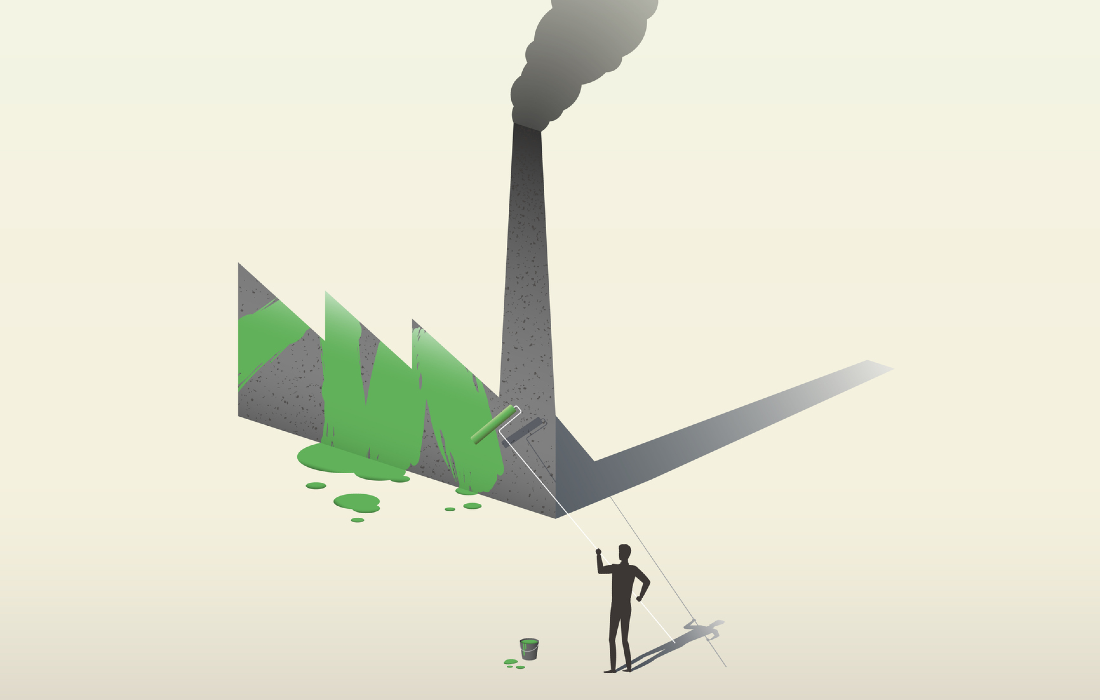Modern blockchain technology to become our weapon in the green transition
Greenwashing scams, murky networks and poor oversight cloud the experiences of climate-conscious consumers and investors. Research from the University of Copenhagen demonstrates that we can create transparency in supply chains, genuinely green products and green financial markets by using distributed ledger technology (DLT).

You are standing in the supermarket aisle with a product in hand. Its packaging is earthy in tone and feel. An idyllic image is accompanied by lofty words about climate neutrality. But there is no indication of the numerous links in the supply chain or where the ingredients come from. Eventually you resign yourself to the fact that there is no way to verify whether the product is more or less sustainable than the cheaper alternatives beside it on the shelf.
Similar scenarios take place on stock exchanges, when climate-conscious investors try to see through greenwashing and, for example, questionable carbon credits, where climate compensation turns out to be bogus.
Solutions to climate, environmental and biodiversity crises require green consumers, green companies and green finance if society is not to come to a complete standstill. But is it possible for someone to know for sure that their morning cup of joe is sustainable, or let investors seeking to finance the green transition know for certain that their money is being used as intended?
Distributed Ledger Technology (DLT) vs. Blockchain
DLT is a database shared between networks of data centers, known as (network) nodes. Each node continuously contributes to including new data, which is then stored on several nodes.
The most well-known example of DLT is blockchain, which is behind cryptocurrencies and smart contracts like Bitcoin and Ethereum. Blockchain is notorious both for being extremely energy-intensive – e.g., Bitcoin consumes about the same amount of energy as a country like Denmark – and for being slow, as all transactions must be recorded in one long chain, which is stored on all nodes in an exact order that all nodes must agree upon.
Conversely, the DLT systems Fritz Henglein works with operate with several separate chains and no requirement that all data be stored on each node.
"In a decentralized DLT system, the nodes are controlled by independent actors. There is no central actor with more access or control over data than the others. At the same time, credibility and consistency are guaranteed – i.e., all data must fit together, which prevents fraud, because all parts of the network have the same information and data cannot be deleted somewhere unnoticed," explains Henglein.
If you ask Professor Fritz Henglein of the Department of Computer Science, the solution is at hand in the form of blockchain technology's big brother – Distributed Ledger Technology (DLT): Unbreakable chains of digitally signed data, which can be added to from multiple entities but cannot be modified or deleted, and which are distributed and stored on a network of computers run by independent actors.
Over the past year, and together with a number of colleagues from the worlds of research, finance and business, Henglein has presented solutions based on DLT that could have great – perhaps revolutionary in the end – potential for the green transition by ensuring transparency in supply chains and financial markets.
"As a tool in the green transition, DLT systems give us a chance to eliminate greenwashing and other types of fraud. But that's just the beginning," says Henglein, who elaborates:
"Basically, we have a problem that we humans transfer carbon dioxide from the earth into the atmosphere. It is done in a way where responsibility gets lost in murky supply chains. This is the fundamental problem we are trying to solve. DLT is a really good place to start because it gives the individual consumer or investor the opportunity to know where their money is going,” he says.

Stories washed green
Lack of transparency – with regards to the actual climate and environmental impact or degree to which green projects actually help – are risks contributing to the public losing confidence in green projects, according to Fritz Henglein.
“Therefore, greenwashing, e.g., where several links in a production chain all register the full carbon reduction of a green project as their own – or projects where the owner moves the emitting part of the production to another place and then calls themself green, is a big problem," he says.
Greenwashing, according to the researcher, is about provenance: how products come to be, not just what they are. The problem is that companies can fetch higher prices with good stories. This provides an incentive for companies to embellish their stories.
"This is why credibility is important. And, credibility requires transparency that can be verified digitally and effectively. The DLT system preserves the entire history of a product, from conception to consumption. And in principle, the sequel as well. If you find registered packaging on a beach, you would also be able to find out who is responsible for the packaging’s recycling, and who can then also document its reuse in new products. That is, from cradle to grave and beyond, circular," he says.
A greener future is REALISTIC
The REALISTIC model presented by Fritz Henglein and his co-authors in a research article can be introduced by companies into their production combined with DLT-based data infrastructure.
With the help of what are known as "digital twins" – digital equivalents of real-world physical products that allow you to gather information about them – companies can record all stages of their production and all of the processes that go into it. The researchers call this Total Resource Accounting.
For example, a coffee farmer records the field of origin and weight of each batch of coffee cherries being sold by them to their local cooperative. When the coffee cherries are to be transported for drying, roasting and ultimately to the consumer, corresponding information is entered into the data chain. An NGO will register that they have verified a farmer's water consumption and cultivation methods, which is subsequently automatically associated with the coffee the farmer produces.
The data chain can neither be broken nor changed. If one link in the production chain cheats on the scales, e.g., adds coffee that has been produced somewhere other than stated, they risk being found out: "You cannot produce 500 grams of certified roasted coffee from only 200 grams of certified coffee cherries", as Henglein puts it.
"This kind of data can be retrieved all the way through to the consumer, who is the last one to have the product in their hand. Each bag of coffee – or a larger batch, depending on the scale you want – is equipped with a digital twin that is updated with all the information about how the product came into being," explains Henglein.
The blockchain coffee test
The researchers have already tested the system in collaboration with Danish coffee roaster Peter Larsen Coffee. To do so, a batch of coffee was produced with the full resource inventory from start to end product using REALISTIC.
"The project demonstrated that this way of creating production and process transparency isn’t something that belongs to the distant future. Both the method and technology are here now, and any company that aims to be at the forefront can begin tomorrow," says Fritz Henglein.
While understanding that the goal may seem utopian to some, Henglein assures that it sounds far more complicated than it is in practice:
"Manufacturers already register what they produce and what they produce it from, just as companies already have ERP and bookkeeping systems in place that contain relevant data that is digitized. So, that part of the task shouldn’t be an obstacle," he says.
According to the professor, individual companies can easily take the lead and implement this to benefit themselves and their customers. But the full potential will only be unleashed once these types of inventories become standard, or at least deployed by actors across major supply chains, which will require the commitment of both companies and public authorities.
New EU legislation sets the stage
The necessary motivation may be approaching. In January, a new EU law was passed requiring companies to report their carbon footprint. For large publicly listed companies, the requirement takes effect in the beginning of 2024. This is where REALISTIC can be of help to companies.
"The system makes it possible to extract data on goods at different levels of detail, including extremely detailed ones. This could, for example, be the total CO2 emissions from the production of one package of coffee up until the point that it arrives at the local supermarket. It will be data that any customer with a smartphone can check by scanning a QR code," Fritz Henglein explains.
This will provide companies with a credible (transparent and verifiable) means of documenting their climate footprint. And, according to the researcher, it will ultimately allow public agencies to collect carbon taxes at the product level, so that any reductions in CO2 emissions becomes a financial gain for those who directly contribute to them.
But at the same time, the system is a smart way for companies to live up to the recently introduced EU requirements for reporting their climate and environmental footprints.
"If companies create their resource inventory using the REALISTIC model, as we propose, and register it in a DLT network they trust, they will have an EU-ready report at any time," says the professor.
Green and transparent investments

Financial markets are another place where DLT systems can provide green transition solutions
A giant step towards a greener future would be taken if consumers and politicians around the world could begin making the right decisions on a truly informed basis. But there is also a need for significantly more green investment, according to reports from the International Renewable Energy Agency (IRENA), an intergovernmental organization dedicated to the green transition of the international energy sector.
"IRENA estimates that roughly €90 trillion needs to be invested in green projects by 2050 if we are to reach the UN's climate goals. This is a major challenge as investors are often uncertain about whether they are actually getting a green investment," says Fritz Henglein.
It requires a financial market that is more transparent and more digitalized, says Fritz Henglein, who points to DLT as a viable option.
"A system that assures investors that they are getting what they paid for is still missing. Such a system could create a new green financing model based on green bonds. Together with colleagues in the finance and research worlds, we have shown that a DLT-based system with wall-to-wall digitalization for green bonds is capable of this task," says Fritz Henglein, referring to a recent research study.
The system was recently tested by the Danish Financial Supervisory Authority (DFSA) and received a positive assessment that confirms it would be able to increase efficiency compared to securities trading with existing systems. The DFSA testing group argues that the system could make Denmark a leader in financial markets for green technology and the green transition by delivering a higher degree of transparency, security and legal certainty at significantly lower risk and cost than the current system.
"In addition to being a more efficient way to act securely, the system also enables full transparency and unique real-time status. This applies to both the securities traded within the system, as well as to the underlying projects they finance. As such, the system makes it easier to check whether investments are actually being used for the purpose stated on the security; For example, whether the carbon credits that one has purchased actually correspond to carbon that has been captured from the atmosphere – and remains sequestered," says Fritz Henglein
Contact
Fritz Henglein
Professor
Department of Computer Science
University of Copenhagen
Phone: +45 35 33 56 92
Mob: +45 30 58 95 76
henglein@di.ku.dk
Kristian Bjørn-Hansen
Journalist and Communications Officer
The Faculty of Science
University of Copenhagen
kbh@science.ku.dk
+45 93 51 60 02.
